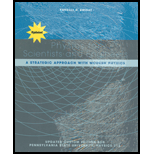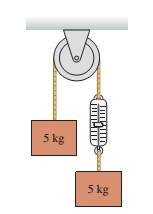
PHYS 212 FOR SCI+ENG W/MAST PHYS >ICP<
1st Edition
ISBN: 9781323834831
Author: Knight
Publisher: PEARSON C
expand_more
expand_more
format_list_bulleted
Concept explainers
Textbook Question
Chapter 7, Problem 11CQ
FIGURE Q7.11 shows two masses at rest. The string is massless and the pulley is frictionless. The spring scale reads in kg. What is the reading of the scale?
FIGURE Q7.11

Expert Solution & Answer
Want to see the full answer?
Check out a sample textbook solution
Students have asked these similar questions
Just 5 and 6 don't mind 7
In an electron gun, electrons are accelerated through a region with an electric field of magnitude 1.5 × 104 N/C for a distance of 2.5 cm. If the electrons start from rest, how fast are they moving after traversing the gun?
Please solve and answer this problem correctly please. Thank you!!
Chapter 7 Solutions
PHYS 212 FOR SCI+ENG W/MAST PHYS >ICP<
Ch. 7 - You find yourself in the middle of a frozen lake...Ch. 7 - How does a sprinter sprint? What is the forward...Ch. 7 - How does a rocket take off? What is the upward...Ch. 7 - How do basketball players jump straight up into...Ch. 7 - A mosquito collides head-on with a car traveling...Ch. 7 - A mosquito collides head-on with a car traveling...Ch. 7 - A small car is pushing a large truck. They are...Ch. 7 - A very smart 3-year-old child is given a wagon for...Ch. 7 - Teams red blue are having a tug-of-war. According...Ch. 7 - Will hanging a magnet in front of the iron cart in...
Ch. 7 - FIGURE Q7.11 shows two masses at rest. The string...Ch. 7 - FIGURE Q7.12 shows two masses at rest. The string...Ch. 7 - The hand in FIGURE Q7.13 is pushing on the back of...Ch. 7 - A and B in FIGURE Q7.14 are connected by a...Ch. 7 - In case a in FIGURE Q7.15, block A is accelerated...Ch. 7 - For Exercises 1 through 5: a. Draw an interaction...Ch. 7 - For Exercises 1 through 5: a. Draw an interaction...Ch. 7 - For Exercises I through 5: a. Draw an interaction...Ch. 7 - For Exercises 1 through 5: a. Draw an interaction...Ch. 7 - For Exercises 1 through 5: a. Draw an interaction...Ch. 7 - a. How much force does an 80 kg astronaut exert on...Ch. 7 - Block B in FIGURE EX7.7 rests on a surface for...Ch. 7 - A 1000 kg car pushes a 2000 kg truck that has a...Ch. 7 - with masses of 1 kg, 2 kg, and 3 kg are lined up...Ch. 7 - A 3000 kg meteorite falls toward the earth. What...Ch. 7 - The foot of a 55 kg sprinter is on the ground for...Ch. 7 - A steel cable lying flat on the floor drags a 20...Ch. 7 - An 80 kg spacewalking astronaut pushes off a 640...Ch. 7 - The sled dog in FIGURE EX7.14 drags sleds A and B...Ch. 7 - Two-thirds of the weight of a 1500 kg car rests on...Ch. 7 - FIGURE EX7.16 shows two 1.0 kg blocks connected by...Ch. 7 - What is the tension in the rope of Figure EX7.17?...Ch. 7 - A 2.0-m-long, 500 g rope pulls a 10 kg block of...Ch. 7 - A woman living in a third-story apartment is...Ch. 7 - Two blocks are attached to opposite ends of a...Ch. 7 - The cable cars in San Francisco are pulled along...Ch. 7 - A 2.0 kg rope hangs from the ceiling. What is the...Ch. 7 - A mobile at the art museum has a 2.0 kg steel cat...Ch. 7 - The 1.0 kg block in FIGURE EX7.24 is tied to the...Ch. 7 - The 100 kg block in FIGURE EX7.25 takes 6.0 s to...Ch. 7 - FIGURE P7.26 shows two strong magnets on opposite...Ch. 7 - FIGURE P7.27 shows a 6.0 N force pushing two...Ch. 7 - 28. A rope of length L and mass m is suspended...Ch. 7 - Prob. 29EAPCh. 7 - 30. A Federation starship (2.0 × 106 kg) uses its...Ch. 7 - Your forehead can withstand a force of about 6.0...Ch. 7 - Bob, who has a mass of 75 kg, can throw a 500 g...Ch. 7 - Two packages at UPS start sliding down the 20°...Ch. 7 - The two blocks in FIGURE P7.34 are sliding down...Ch. 7 - The coefficient of static friction is 0.60 between...Ch. 7 - The block of mass M in FIGURE P7.36 slides on a...Ch. 7 - The 10.2 kg block in FIGURE P7.37 is held in place...Ch. 7 - The coefficient of kinetic friction between the...Ch. 7 - FIGURE P7.39 shows a block of mass m resting on a...Ch. 7 - A4.0 kg box is on a frictionless 35° slope and is...Ch. 7 - Prob. 41EAPCh. 7 - The 2000 kg cable car shown in FIGURE P7.42...Ch. 7 - The century-old ascensores in Valparaiso, Chile,...Ch. 7 - A 3200 kg helicopter is flying horizontally. A 250...Ch. 7 - A house painter uses the chair-and-pulley...Ch. 7 - A long, 1.0 kg rope hangs from a support that...Ch. 7 - Prob. 47EAPCh. 7 - Prob. 48EAPCh. 7 - Find an expression for the magnitude of the...Ch. 7 - Prob. 50EAPCh. 7 - Prob. 51EAPCh. 7 - Prob. 52EAPCh. 7 - The lower block in FIGURE CP7.53 is pulled on by a...Ch. 7 - Prob. 54EAPCh. 7 - Prob. 55EAPCh. 7 - A 40-cm-diameter, 50-cm-tall, 15 kg hollow...Ch. 7 - 57. FIGURE CP7.57 shows a 200 g hamster sitting on...Ch. 7 - Prob. 58EAP
Knowledge Booster
Learn more about
Need a deep-dive on the concept behind this application? Look no further. Learn more about this topic, physics and related others by exploring similar questions and additional content below.Similar questions
- Please solve and answer this problem correctly please. Thank you!!arrow_forwarda) Use the node-voltage method to find v1, v2, and v3 in the circuit in Fig. P4.14. b) How much power does the 40 V voltage source deliver to the circuit? Figure P4.14 302 202 w w + + + 40 V V1 80 Ω 02 ΣΑΩ 28 A V3 + w w 102 202arrow_forwardPlease solve and answer this problem correctly please. Thank you!!arrow_forward
- You're on an interplanetary mission, in an orbit around the Sun. Suppose you make a maneuver that brings your perihelion in closer to the Sun but leaves your aphelion unchanged. Then you must have Question 2 options: sped up at perihelion sped up at aphelion slowed down at perihelion slowed down at aphelionarrow_forwardThe force of the quadriceps (Fq) and force of the patellar tendon (Fp) is identical (i.e., 1000 N each). In the figure below angle in blue is Θ and the in green is half Θ (i.e., Θ/2). A) Calculate the patellar reaction force (i.e., R resultant vector is the sum of the horizontal component of the quadriceps and patellar tendon force) at the following joint angles: you need to provide a diagram showing the vector and its components for each part. a1) Θ = 160 degrees, a2) Θ = 90 degrees. NOTE: USE ONLY TRIGNOMETRIC FUNCTIONS (SIN/TAN/COS, NO LAW OF COSINES, NO COMPLICATED ALGEBRAIC EQUATIONS OR ANYTHING ELSE, ETC. Question A has 2 parts!arrow_forwardThe force of the quadriceps (Fq) and force of the patellar tendon (Fp) is identical (i.e., 1000 N each). In the figure below angle in blue is Θ and the in green is half Θ (i.e., Θ/2). A) Calculate the patellar reaction force (i.e., R resultant vector is the sum of the horizontal component of the quadriceps and patellar tendon force) at the following joint angles: you need to provide a diagram showing the vector and its components for each part. a1) Θ = 160 degrees, a2) Θ = 90 degrees. NOTE: USE DO NOT USE LAW OF COSINES, NO COMPLICATED ALGEBRAIC EQUATIONS OR ANYTHING ELSE, ETC. Question A has 2 parts!arrow_forward
- No chatgpt pls will upvotearrow_forwardThe force of the quadriceps (Fq) and force of the patellar tendon (Fp) is identical (i.e., 1000 N each). In the figure below angle in blue is Θ and the in green is half Θ (i.e., Θ/2). A) Calculate the patellar reaction force (i.e., R resultant vector is the sum of the horizontal component of the quadriceps and patellar tendon force) at the following joint angles: you need to provide a diagram showing the vector and its components for each part. a1) Θ = 160 degrees, a2) Θ = 90 degrees. NOTE: USE ONLY TRIGNOMETRIC FUNCTIONS (SIN/TAN/COS, NO LAW OF COSINES, NO COMPLICATED ALGEBRAIC EQUATIONS OR ANYTHING ELSE, ETC. Question A has 2 parts!arrow_forwardNo chatgpt pls will upvotearrow_forward
- No chatgpt pls will upvotearrow_forwardSolve and answer the question correctly please. Thank you!!arrow_forward་ The position of a particle is described by r = (300e 0.5t) mm and 0 = (0.3t²) rad, where t is in seconds. Part A Determine the magnitude of the particle's velocity at the instant t = 1.5 s. Express your answer to three significant figures and include the appropriate units. v = Value Submit Request Answer Part B ? Units Determine the magnitude of the particle's acceleration at the instant t = 1.5 s. Express your answer to three significant figures and include the appropriate units. a = Value A ? Unitsarrow_forward
arrow_back_ios
SEE MORE QUESTIONS
arrow_forward_ios
Recommended textbooks for you
 Physics for Scientists and Engineers: Foundations...PhysicsISBN:9781133939146Author:Katz, Debora M.Publisher:Cengage Learning
Physics for Scientists and Engineers: Foundations...PhysicsISBN:9781133939146Author:Katz, Debora M.Publisher:Cengage Learning Glencoe Physics: Principles and Problems, Student...PhysicsISBN:9780078807213Author:Paul W. ZitzewitzPublisher:Glencoe/McGraw-Hill
Glencoe Physics: Principles and Problems, Student...PhysicsISBN:9780078807213Author:Paul W. ZitzewitzPublisher:Glencoe/McGraw-Hill University Physics Volume 1PhysicsISBN:9781938168277Author:William Moebs, Samuel J. Ling, Jeff SannyPublisher:OpenStax - Rice University
University Physics Volume 1PhysicsISBN:9781938168277Author:William Moebs, Samuel J. Ling, Jeff SannyPublisher:OpenStax - Rice University Principles of Physics: A Calculus-Based TextPhysicsISBN:9781133104261Author:Raymond A. Serway, John W. JewettPublisher:Cengage Learning
Principles of Physics: A Calculus-Based TextPhysicsISBN:9781133104261Author:Raymond A. Serway, John W. JewettPublisher:Cengage Learning Physics for Scientists and Engineers, Technology ...PhysicsISBN:9781305116399Author:Raymond A. Serway, John W. JewettPublisher:Cengage Learning
Physics for Scientists and Engineers, Technology ...PhysicsISBN:9781305116399Author:Raymond A. Serway, John W. JewettPublisher:Cengage Learning College PhysicsPhysicsISBN:9781305952300Author:Raymond A. Serway, Chris VuillePublisher:Cengage Learning
College PhysicsPhysicsISBN:9781305952300Author:Raymond A. Serway, Chris VuillePublisher:Cengage Learning

Physics for Scientists and Engineers: Foundations...
Physics
ISBN:9781133939146
Author:Katz, Debora M.
Publisher:Cengage Learning

Glencoe Physics: Principles and Problems, Student...
Physics
ISBN:9780078807213
Author:Paul W. Zitzewitz
Publisher:Glencoe/McGraw-Hill

University Physics Volume 1
Physics
ISBN:9781938168277
Author:William Moebs, Samuel J. Ling, Jeff Sanny
Publisher:OpenStax - Rice University

Principles of Physics: A Calculus-Based Text
Physics
ISBN:9781133104261
Author:Raymond A. Serway, John W. Jewett
Publisher:Cengage Learning

Physics for Scientists and Engineers, Technology ...
Physics
ISBN:9781305116399
Author:Raymond A. Serway, John W. Jewett
Publisher:Cengage Learning

College Physics
Physics
ISBN:9781305952300
Author:Raymond A. Serway, Chris Vuille
Publisher:Cengage Learning
Newton's First Law of Motion: Mass and Inertia; Author: Professor Dave explains;https://www.youtube.com/watch?v=1XSyyjcEHo0;License: Standard YouTube License, CC-BY